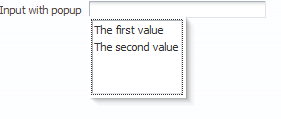In this post I'm going to show how to add train stops to ADF train programmatically "on-the-fly". In my use-case I have some ticket-booking application. It has a bounded task flow with train model. At the first stop of the train users input number of passengers and at the following stops they input some passengers' info. The number of stops with passengers' info has to be changed dynamically depending on the value submitted at the first train stop. So, the result of described behaviour should look like this:
The bounded task flow has the following structure:
StartView activity is a page fragment where we input number of passengers and DynamicView activity provides a page fragment to input passenger's info. At the moment we have only one activity for passenger's info and I will add extra activities if the number of passengers is greater than one.
The inputNumberSpinbox in StartView page fragment submits its value to passengersNumber property of some PageFlowScope backing bean and action for the Submit button is a method of the same bean:
The bounded task flow has the following structure:
StartView activity is a page fragment where we input number of passengers and DynamicView activity provides a page fragment to input passenger's info. At the moment we have only one activity for passenger's info and I will add extra activities if the number of passengers is greater than one.
The inputNumberSpinbox in StartView page fragment submits its value to passengersNumber property of some PageFlowScope backing bean and action for the Submit button is a method of the same bean:
public class MainTrain {
//Extra added train stops
private List<ActivityId> dynamicStops = new ArrayList<ActivityId>();
//Value of inputNumberSpinbox
private int passengersNumber = 1;
public String buttonPress(){
//The number of extra added train stops is greater than needed
if (passengersNumber <= dynamicStops.size())
clearExtraStops();
else //The number of extra added train stops is less than needed
if (passengersNumber-1 > dynamicStops.size())
addDynamicStops();
return null;
}
So, by pressing on Submit button we either add some train stops or clear extra stops depending on the value of inputNumberSpinbox. We save all added dynamic stops in dynamicStops list. Let's have a look at the clearExtraStops() method:
private void clearExtraStops() {
for (int i = dynamicStops.size(); i >= passengersNumber; i--) {
//Get ActivityId to be removed
ActivityId removeActivityId = dynamicStops.get(i-1);
//Get current train model and remove train stop
TrainModel trainModel = TrainUtils.findCurrentTrainModel();
trainModel.getTrainStops().remove(removeActivityId);
//Remove activity from task flow definition
getTaskFlowDefinition().getActivities().remove(removeActivityId);
dynamicStops.remove(i-1);
}
}
The method removes two things: the train stop from the train model and the activity from the task flow definition. The addDynamicStops() method is going to be much more interesting:
private void addDynamicStops() {
for (int i = dynamicStops.size(); i < passengersNumber - 1; i++) {
//Creating new ActivityId
ActivityId activityId =
new ActivityId(getTaskFlowId(), new StringBuilder("DynamicView").append(i).toString());
//The main trick of the post.
//We consider DynamicView activity as a base for new train stop and new activity
//Get base activity (DynamicView) and its train stop
Activity baseActivity = getBaseDynamicActivity();
TrainStopContainer stopContainer = (TrainStopContainer)baseActivity.getMetadataObject();
TrainStop baseTrainStop = stopContainer.getTrainStop();
//Create new Activity based on DynamicView but with new ActivityId
ActivityImpl activityImpl = new ActivityImpl(baseActivity, activityId);
//Add created activity to the task flow definition
getTaskFlowDefinition().getActivities().put(activityId, activityImpl);
//Create new train stop based on the DynamicView's train stop
TrainStopModel trainStopModel = new TrainStopModel(
new TrainStopImpl(baseTrainStop, i+2), activityId);
//Add created train stop to the train stop model
TrainModel trainModel = TrainUtils.findCurrentTrainModel();
trainModel.getTrainStops().put(activityId, trainStopModel);
//Add created activity to our list
dynamicStops.add(activityId);
}
}
private Activity getBaseDynamicActivity() {
ActivityId baseActivityId = new ActivityId(getTaskFlowId(), "DynamicView");
MetadataService metadataService = MetadataService.getInstance();
return metadataService.getActivity(baseActivityId);
}
private TaskFlowDefinition getTaskFlowDefinition() {
MetadataService metadataService = MetadataService.getInstance();
return metadataService.getTaskFlowDefinition(getTaskFlowId());
}
private TaskFlowId getTaskFlowId() {
ControllerContext controllerContext = ControllerContext.getInstance();
ViewPortContext currentViewPortCtx = controllerContext.getCurrentViewPort();
TaskFlowContext taskFlowCtx = currentViewPortCtx.getTaskFlowContext();
return taskFlowCtx.getTaskFlowId();
}
So, the principal trick of this post is to create new activity and train stops basing on existing ones for DynamicView. In order to implement the idea I created two classes: ActivityImpl and TrainStopImpl. The classes are nothing else than just proxy classes implementing Activity and TrainStop interfaces correspondently. They delegates interface implementation to the base instances except some specific methods like getters for Id and DisplayName:
public class TrainStopImpl implements TrainStop {
//Base instance
private TrainStop baseTrainStop;
private int mpassNo;
private static final String PASSANGER_FORM = "Passenger's data: ";
public TrainStopImpl(TrainStop trainStop, int passNo) {
baseTrainStop = trainStop;
mpassNo = passNo;
}
//Specific implementation
public String getDisplayName() {
return new StringBuilder(PASSANGER_FORM).append(mpassNo).toString();
}
public String getOutcome() {
return baseTrainStop.getOutcome();
}
public String getSequential() {
return baseTrainStop.getSequential();
}
...
public class ActivityImpl implements Activity {
private Activity baseActivity;
private ActivityId mid;
public ActivityImpl(Activity activity, ActivityId id) {
baseActivity = activity;
mid = id;
}
//Specific implementation
public ActivityId getId() {
return mid;
}
public String getType() {
return baseActivity.getType();
}
public Object getMetadataObject() {
return baseActivity.getMetadataObject();
}
...
And one more picture for this post, just to show it's working:
That's all! You can download sample application for JDeveloper 11.1.1.2.0.





